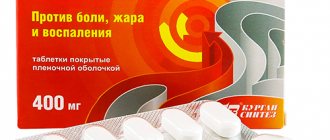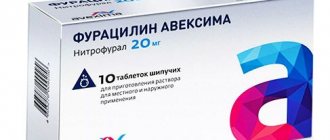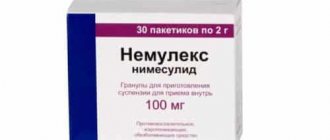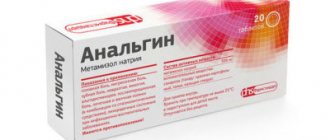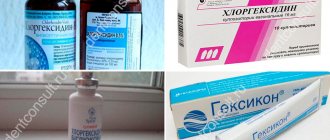pharmachologic effect
Anti-inflammatory, antipyretic, analgesic.
Pharmacokinetics
Nimesulide is well absorbed from the gastrointestinal tract (GIT).
The maximum concentration in blood plasma (Cmax) after oral administration of a single dose of nimesulide, amounting to 100 mg, is achieved on average after 2 - 3 hours and is 3-4 mg / l. Area under the concentration-time curve (AUC) and a decrease in the cumulative excretion of furosemide without changing the renal clearance of furosemide.
Indications
Nimesil is prescribed to reduce pain and inflammation during the treatment of the following diseases and symptoms:
- acute muscle and musculoskeletal pain;
- toothache;
- pain during the treatment of osteoarthritis;
- dysalgomenorrhea.
In addition, the drug is actively used as an antipyretic for the treatment of acute respiratory viral infections and colds of varying degrees of complexity.
Effect on the body
The drug easily overcomes histohematic barriers and is absorbed from the gastrointestinal tract within 2-3 hours after administration. About half of the drug taken is eliminated by the kidneys. Experimental studies involving patients with clinically confirmed renal failure and healthy volunteers showed that the concentration of nimesulide was within the acceptable range. However, only patients with mild and moderate stages of renal failure were allowed to participate in the study. The next time Nimesil was used, no accumulation of the active substance in the body was detected.
Nimesil dosage
Inside. The contents of the sachet are dissolved in approximately 100 ml of water at room temperature (a white or light yellow suspension is formed).
The prepared solution cannot be stored.
The drug Nimesil® is used only for the treatment of patients over 12 years of age.
Adults and children over 12 years old: 1 sachet twice a day, after meals.
Elderly patients: when treating elderly patients, the need to adjust the daily dose is determined by the doctor based on the possibility of interaction with other drugs.
Patients with renal insufficiency: in patients with mild to moderate renal insufficiency (creatinine clearance 30-60 ml/min) no dose adjustment is required, while in patients with severe renal insufficiency (creatinine clearance <30 ml/min) Nimesil ® is contraindicated.
Patients with liver failure:
The use of Nimesil® in patients with liver failure is contraindicated.
To reduce the likelihood of side effects, it is recommended to take the minimum effective dose for the shortest possible time.
The maximum daily dose for adults and children over 12 years of age is 200 mg.
The maximum duration of treatment is 15 days.
Release forms and dosages
The drug is produced in granules, from which a suspension is prepared for oral administration. The granules are placed in sealed bags of 2 g. You can buy Nimesil in packages of 9, 15, 30 sachets. The drug is prescribed only to adults. For elderly people, the dosage is selected individually based on the severity of the disease and the effectiveness of the drug. Take the medicine only after meals.
Composition and active substance
The main active ingredient of Nimesil is Nimesulide. One two-gram sachet of the drug contains one hundred milligrams of the active substance. Nimesulide is supplemented with other components - sucrose, ketomacrogol, anhydrous citric acid, maltodextrin and orange flavor.
Overdose
Symptoms: apathy, drowsiness, nausea, vomiting, pain in the epigastric region. These symptoms are usually reversible with symptomatic and supportive therapy. Possible increased blood pressure, gastrointestinal bleeding, acute renal failure, respiratory depression, coma, anaphylactoid reactions.
Treatment: Symptomatic and supportive therapy. There is no specific antidote. If an overdose has occurred within the last 4 hours, it is necessary to induce vomiting and/or take activated carbon (60 to 100 g for an adult) and/or an osmotic laxative. Forced diuresis, hemodialysis, hemoperfusion, and urine alkalization are ineffective due to the high degree of binding of nimesulide to plasma proteins (up to 97.5%). It is necessary to monitor the state of kidney and liver function.
Drug interactions
The drug enhances the effect of medications that are used to reduce blood clotting. Nimesil can also increase the effect of furosemide. When taking Nimesil and methotrexate simultaneously, side effects may worsen. Nimesulide quickly binds to plasma proteins, so persons treated with sulfonamides and hydantoin should be under close medical supervision. The drug enhances the effect of cyclosporine on the kidneys. If Nimesil is used simultaneously with lithium preparations, the concentration of lithium in the plasma will increase.
Treatment with Nimesil requires caution if blood pressure medications, diuretics, or other anti-inflammatory and painkillers are used in combination with it.
Precautionary measures
Carefully
Arterial hypertension, diabetes mellitus, compensated heart failure, coronary heart disease, cerebrovascular diseases, dyslipidemia/hyperlipidemia, peripheral arterial disease, hemorrhagic diathesis, smoking, creatinine clearance 30-60 ml/min.
History of ulcerative lesions of the gastrointestinal tract; history of infection caused by Helicobacter pylori; elderly age; long-term previous use of NSAIDs; severe somatic diseases.
Concomitant use with the following drugs: anticoagulants (for example, warfarin), antiplatelet agents (for example, acetylsalicylic acid, clopidogrel), oral glucocorticosteroids (for example, prednisolone), selective serotonin reuptake inhibitors (for example, citalopram, fluoxetine, paroxetine, sertraline).
special instructions
According to Nimesil's instructions, if the patient has a risk of ulcers, gastrointestinal bleeding, as well as with simultaneous treatment with drugs from the above, Nimesil therapy is started with the lowest dose, monitoring the patient's condition. At the slightest side or undesirable reactions, treatment is stopped.
- Nimesil contains sucrose, which should be taken into account by patients with diabetes: 1 sachet contains 0.15-0.18 XE.
- If ARVI and colds occur during Nimesil therapy, treatment is stopped.
- During treatment with Nimesil, caution should be exercised when driving a car and performing precise, dangerous work.
For what diseases do you need to take nimesil?
The drug is used as prescribed by a doctor as a “second-line” medication and is added to therapy additionally when other drugs fail to relieve an attack of pain and relieve symptoms of inflammation that are caused by:
- toothache;
- painful menstruation and inflammation of the genital organs in women and men;
- damage to joints and ligaments that occur due to injuries, dislocations, fractures, sprains;
- pain in the spine and back;
- degenerative changes in joints with osteoarthritis.
Adverse reactions
Both drugs can cause side effects:
- - dizziness;
- – attacks of nausea;
- - vomit;
- – excessive sweating;
- - vomit;
- – depressive state;
- – nervousness;
- – hearing and vision impairments;
- - headache;
- – asthma attacks;
- – reduction in the number of blood cells;
- - increased blood pressure;
- – tachycardia;
- – protein in urine;
- – renal and liver failure;
- – shortness of breath;
- – gastric bleeding;
- – high concentration of liver enzymes;
- – swelling;
- – problems with urination;
- – low body temperature;
- – hepatitis.
Simethicone or Espumisan, which is better and more effective?
Taking medications can provoke allergic rashes, bronchospasm and anaphylactic shock. At the first manifestation of such symptoms, you should urgently stop taking the drug and consult a doctor.
Contraindications
"Nimesil" is contraindicated for use in the following diseases and conditions:
- Peptic ulcer, accompanied by damage to the mucous membrane of the duodenum and stomach. This is due to the effect of nimesulide on prostaglandins, which, among other things, have a protective effect on the mucous membrane of the gastrointestinal tract.
- The patient has a history of bleeding in the gastrointestinal tract, including those caused by peptic ulcer.
- Chronic intestinal diseases of a non-infectious nature, accompanied by an inflammatory process and in the acute stage (for example, ulcerative colitis of a nonspecific nature).
- Fever that provokes an increase in body temperature, especially in acute viral pathology, as well as bacterial infectious diseases.
- Allergic diseases, including a combination of bronchial asthma, polynosis and an individual reaction to acetylsalicylic acid, which is part of non-steroidal anti-inflammatory drugs.
- Severe hypersensitivity to acetylsalicylic acid, accompanied by bronchospasm, urticaria or inflammation of the nasal mucosa.
- The recovery period after surgery, including coronary artery bypass grafting.
- The patient has a history of diseases caused by hemorrhagic stroke of the brain, as well as a high probability of bleeding.
- Severe bleeding disorders, including a decrease in the working activity of hemostasis.
- A pronounced decrease in heart activity against the background of severe organ failure.
- Combination with drugs that negatively affect the condition of the liver, namely hepatotoxic drugs.
- Severe liver and kidney failure.
- Chronic drug or alcohol addiction.
- Children under 12 years of age.
- The period of bearing a child and breastfeeding.
- Individual intolerance to the components of the drug.
Analogs
Pharmacies are ready to offer quite a lot of drugs that are analogues of Nimesil. If you believe the reviews, generics are identical to the original in properties and composition.
“Nise”, “Nemulex”, “Nimesulide” contain the same active ingredient as “Nimesil”, so in principle they are not able to act on the body otherwise. It should be noted that the concentration of the active substance in the listed drugs is identical.
No less effective drugs analogues of Nimesil are:
- "Aponil."
- "Kostral".
- "Mesulide".
- "Nimulid".
- "Nimesan".
- "Niminka."
- "Aulin."
- "Nimegesik", etc.
Many patients suffering from headaches or toothaches often face a choice between Nimesil and Nise. The latter is an effective and cheaper drug, while Nise is produced both in powder and tablet form. It can be given even to children in small dosages.
"Nemulex" and "Nimesil" are absolutely identical drugs. The only thing that differs is their taste, as they contain different excipients. Nemulex is cheaper, so many people choose it.
